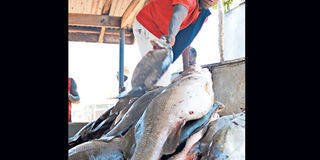Four ways to make tasty fish at home

A man sorts fish. Harvested fish should be kept wet until the scales are removed and then soaked in water for a few minutes to ease scaling. FILE PHOTO | NMG
What you need to know:
- Fish is highly perishable and should be cleaned as soon as it is out of the water.
- The preparation process starts with scaling.
- To avoid splashing or cooling down hot oil when you place the fish in a hot frying pan, dry it off before cooking by hanging it on a rack or a chopping board.
- Note that catfish has no scales but the skin should be tight, adhering well and easy to detach and cut.
The value chain approach to agricultural production entails planning for activities from the farm to table.
This approach raises awareness on the on-farm and off-farm activities that can be exploited to earn an income by various actors, with farmers playing the central role.
The actors along the chain are, therefore, referred to as agro-input suppliers, farmers (agro-producers), agro-transporters, agro-processors, agro-dealers (marketers) and finally the consumers.
To explain the concept, let us take fish processing or marketing. Issues that one needs to understand in this value chain activity include knowing how to identify fresh fish, pre-preparation activities and the cooking methods that include deep fry, wet fry and stew and soup, among others. One can perfect cooking at home before commercialising it.
Identification of fresh fish
Areas to examine include the general appearance of the fish. The product should have a lustrous pigmentation with no blood and scales that should be bright and firmly attached but comes out easily.
The eyes should be clear, bright, convex (bulging) and occupying all the eye cavity. The gills should be humid, shiny, pink or red dry with a gill cover that adheres firmly with no blood spots. Note that catfish has no scales but the skin should be tight, adhering well and easy to detach and cut.
Pre-preparation activities
Fish is highly perishable and should be cleaned as soon as it is out of the water. It should then be kept wet until scales are removed. Soak in water for a few minutes to ease scaling.
The preparation process starts with scaling. Place the fish on a clean surface and hold it firmly by the head and scrape the scales from the tail towards the head with a blunt knife.
Do the same on the other side. Gutting follows and involves removal of the internal organs. Mark an incision in the belly from the anal opening and cut through the skin to the head. Remove the guts and gills and then rinse the inside of the fish with cold running water.
To avoid splashing or cooling down hot oil when you place the fish in a hot frying pan, dry it off before cooking by hanging it on a rack or a chopping board.
To increase permeability of spices, make three or more parallel shallow cuts running from the belly to the back.
Deep fry
Two medium size tilapia fish will require two teaspoonful of salt and one cup of oil. Rub salt all over fish, including the inside and the open cuts. Then heat oil in a pan and gently lower the already prepared fish into the pot, let it cook until it turns golden brown.
This method is suitable for all the farmed fish that include tilapia, catfish, trout and common carp, among others. The fish can be served with ugali and vegetables such as African night shade (managu), collard greens (sukuma wiki) and spinach or vegetable salad. Squeezing a few drops of fresh lemon juice on the fish makes it tender and tastier.
Wet-fry
Ingredients for one deep fried table size fish (500g) include an onion, two large tomatoes, dhania (coriander), crushed ginger and crushed garlic.
Fry onion in little oil in cooking pot and add tomatoes, dhania, the spices mixture and salt to taste. Cook to form paste.
Add the fish pieces and cover to simmer for five minutes. Serve with ugali and green local vegetables. You can have side pieces of lemon for squeezing onto the fish
Fish stew
The ingredients for two pieces of raw table size fish (500g each) are the same as in wet fry. Fry onion in little oil in cooking pot and add tomatoes, dhania, the spices mixture and salt to taste. Cook to form paste; add enough water to cover the fish when immersed in the pot.
Cook for 20 minutes or until the fish is firm and the soup has reduced to about a half of the original water. Serve with rice or ugali and local vegetables. Note that unlike wet-fry, the fish here has not been deep fried and is therefore good for people who are targeting low fat foods.
Fish soup
This method is good for fish like catfish which have a big head/bones. Split the head lengthwise into two and dry both sides on burning charcoal. Scrape off any soot and put it in a pot with water. Boil thoroughly until the soup is whitish.
Take soup with or without salt.
The meaty contents can also be eaten without further processing or can be put in the wet fry paste, covered and left to simmer for five minutes.
Serve with ugali and greens. One cup of such soap sells at Sh20 in local fish eating outlets.
Talk to Dr Mwirigi at [email protected]




